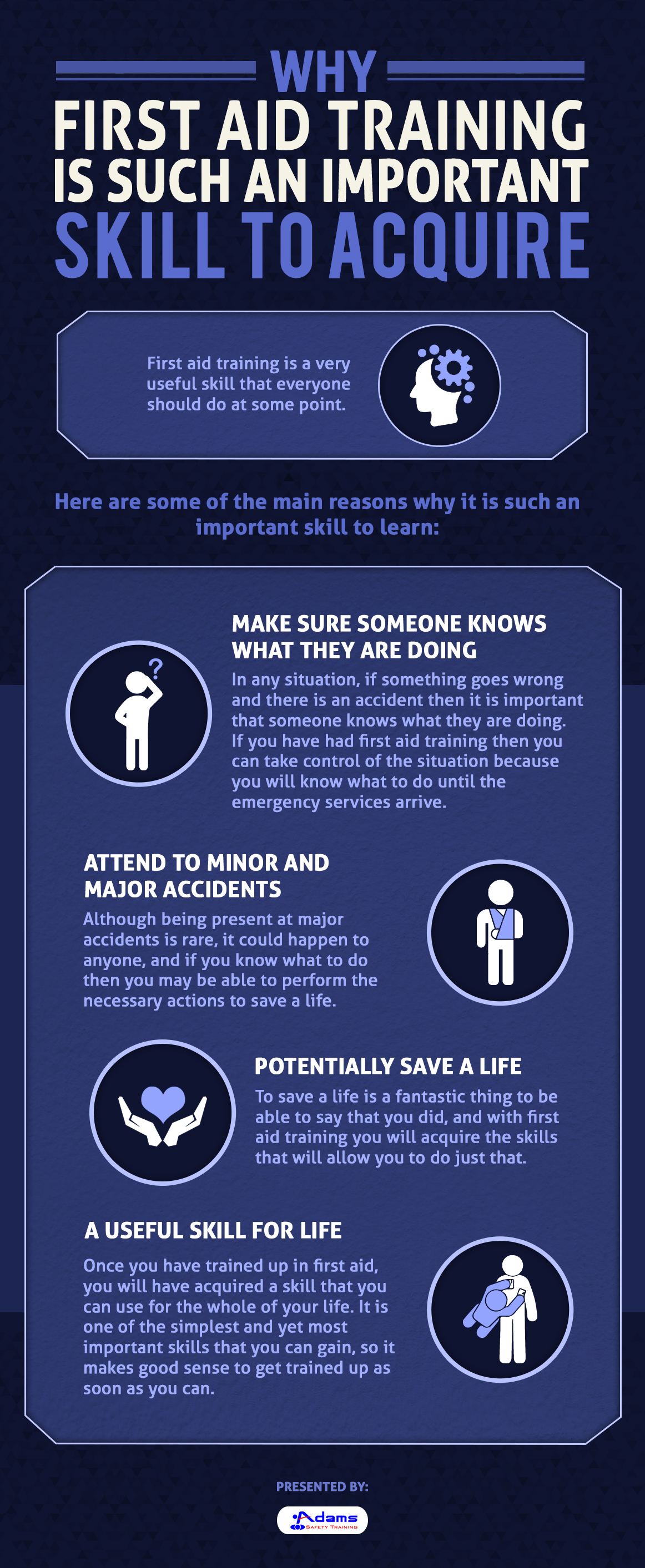
Reason to Get CPR Classes [Infographic]
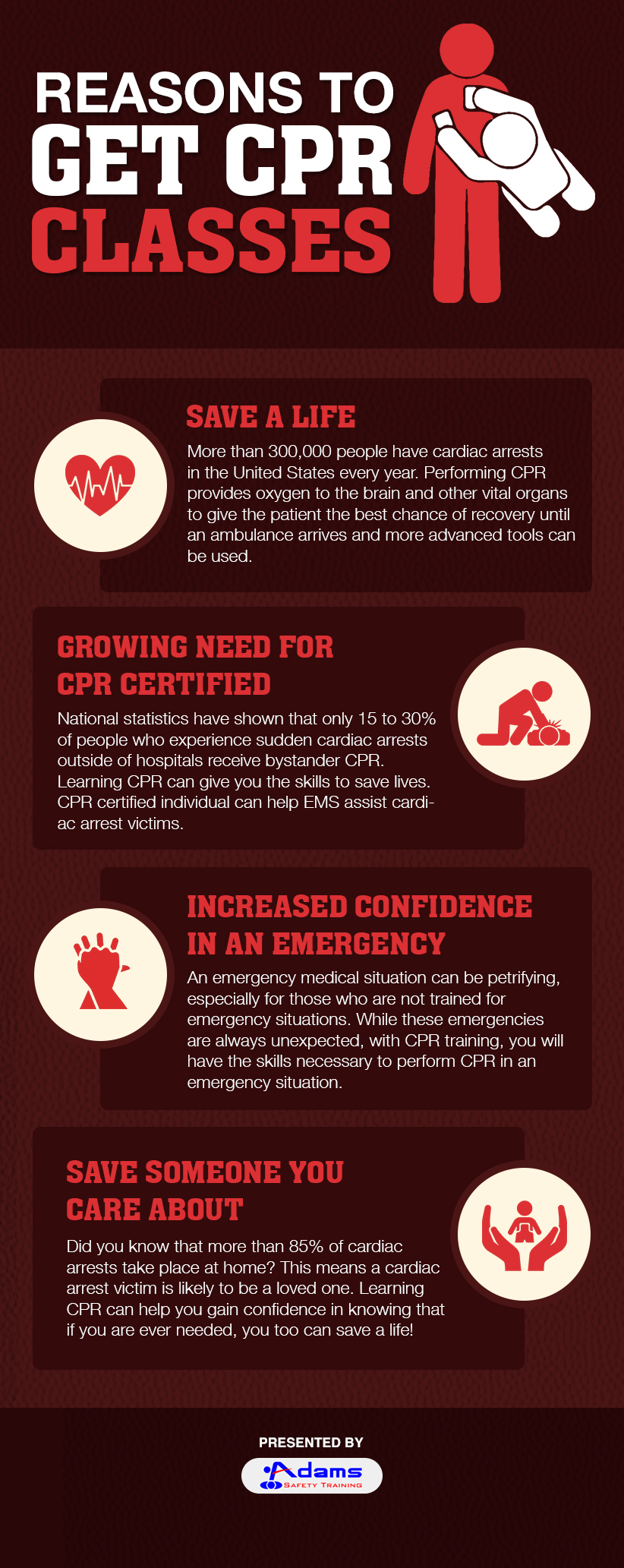
AED
Cardio Pulmonary Resuscitation, often abbreviated as CPR delivers a small amount of blood to the heart, keeping the body and the brain to function until defibrillation takes place. Defibrillation is a shock offered to the heart to restart its regular function.
Most of the licensed classes in CPR training include AED certification, which teaches how to use the electronic defibrillation unit on heart attack victims. AED Certification San Ramon is required by Doctors, nurses, dentists, licensed physiotherapists, and chiropractors, or other health professionals.
WHAT IS AN AED?
AED is an instrument used to complement CPR.
Automated external defibrillator (AED) is a lightweight, mobile device that gives an electric shock through the chest to the heart. It is used to help those people who are going through a sudden cardiac arrest.
Adams safety helps the individual/group to get an AED Certification San Ramon. An AED certified professional will be guided well and he needs to follow the following steps to use AED:
Firstly an AED certified person needs to find the pulse and check if the person is breathing.
In case the pulse can’t be found emergency help needs to be called for.
The specialist needs to turn on AED and the voice instructions will follow after that. It tells how to check the pulse and acknowledge whether the person is breathing or not. It will guide how to position electrode pads on the person’s chest.
The next step is to deliver the shock. Once the pads are placed in the position, the AED device itself measures the person’s heart rhythm and determines if the shock is required. If it is, then the device instructs the user to maintain a distance and push the button to deliver the shock.
Cardio Pulmonary Resuscitation is required after the shock. The AED will guide the same. The process can be repeated as required until the emergency course of action takes place.
How First Aid Training can Help in All Walks of Life [Infographic]
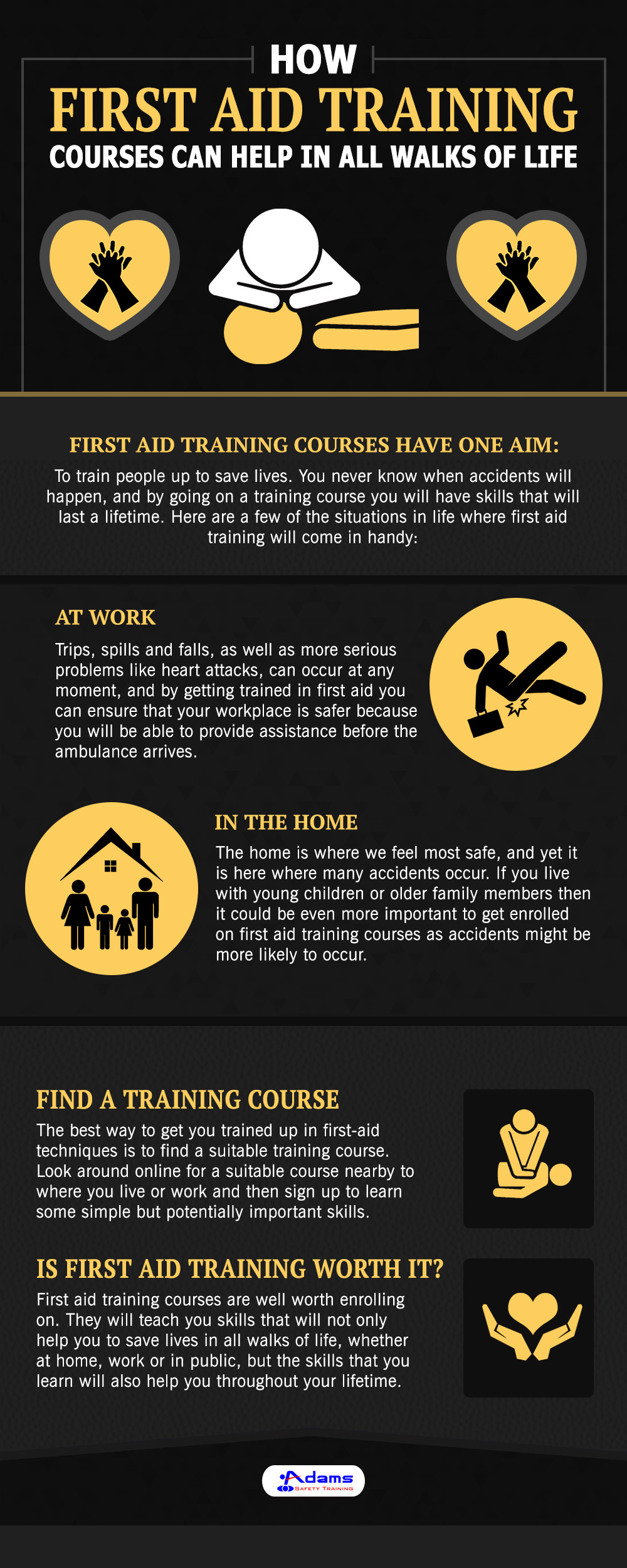
REASONS WHY AHA CERTIFICATION IS IMPORTANT
The AHA (American Heart Association) provides the best online knowledge repository called American Heart University. Course titles may differ from those of the American Red Cross (ARC) or the National Safety Council (NSC) but the basic concepts of CPR are the same, irrespective of the research case studies held in the United States.
AHA provides you with a variety of career-oriented courses, designed to help become a better professional and enhance your leadership abilities.
Key features of our mentoring program of AHA Certification San Ramon let you widen your scope and knowledge. Let’s have a quick look at them:
1. Helps in saving lives:
A Study says that Four out of five cardiac arrest incidents happen at home. A cardiac arrest victim’s possibility of survival decreases by 10 percent. An AHA CPR-certified individual can help in saving someone’s life in emergencies with his knowledge of CPR skills.
2. Helps in identifying a sudden cardiac arrest:
Statistical data of AHA identifies that 92 percent of SCA victims die before arriving at some medical institution. Chances of survival are doubled or can be tripled at times if immediate CPR is provided to the victims.
3. Helps in becoming a responsible citizen:
Possessing knowledge of CPR skills can make you more valuable at your office as well as at home. If any of your loved ones at home or any co-worker suddenly experiences a cardiac arrest, you can take the necessary action. Our classes for AHA Certification San Ramon are designed such that it makes it easy for a bigger group of individuals to learn CPR together.
4. Helps in learning AED working:
CPR certification also includes AEDs training, which teaches you how to use an AED promptly and thus reduces the possibility of a loss of life in SCA emergencies.
Who should go for EMSA Training?
We are authorized by the California Emergency Medical Services Authority (EMSA) to provide training in preventive practices: Realization, governance, and prevention of infectious diseases, including immunizations, and control of childhood injuries.
What is EMSA Training?
EMSA Training takes care of all emergency situations that are often faced by individuals who look after infants and small children. Authorized classes are of 16 hours. It is divided into:
1)First Aid and Pediatric CPR – 4 Hour each
The classes underline First-Aid preparedness. Children, especially infants, may need extra care when administrating First-Aid, specifically CPR. Adding-on, the classes also teach care providers that children with a chronic medical condition should be treated in a proper manner.
2)Preventive Health and Safety practices- 8 Hours
The curriculum adds training in sanitary food handling, emergency preparedness and evacuation, care for differently-abled children, identification of symptoms of child abuse, and child nutrition. This can be defined as
1.Infection Control Policies & Procedures
2.Immunization Laws & Recordkeeping
3.Nutrition and the Childcare Food Program
4.Injury Prevention
5.Quality Care in Early Childhood
6.Cultural Sensitivity in Childcare
7.American with Disabilities Act in the Childcare
8.The Preventive Health Practices
Who should go for this training?
Childcare Provider Administrators & Daycare Owners
Privately owned daycare owners that leave staff unattended are required by law to get those staff members EMSA Safety Certified.
What does EMSA do to ensure child care professionals are properly trained?
EMSA carries out inspections in Maritime Education and Training (MET) Institutions of the Member States and Third Countries. The main idea is to confirm the method that the organizations are executing:
Standards of Training, Certification, and Watchkeeping (STCW)
Convention (quality of systems and procedures)
Human resources and equipment.
The inspections not only ensure the STCW standards are properly applied but also enable the organizations to identify areas that require modifications.
Why is Forklift Safety Training worth Investing?
Safety training is one of the first and foremost investments a facility manager needs to come up with. Incidental analysis proves there is a direct and often tragic relationship between incompetent training and workplace mishaps.
The primary requisite of forklift certification is safety. The bear-sized industrial machines take almost negligible time to create disturbance. Hence, the workers working on these lift trucks should be equipped lawfully.
The operators play a key role in assuring suitable and safe utilization of forklifts. Entrepreneurs must come up with legitimately ensured and prepared operators on-board. For those organizations that don’t have a detailed administration check, absence of forklift safety training can be a major issue. It may result in some accidental happening at some point of time.
Having a certified forklift operator may help a business in the following ways:
1. Greater productivity: If an accident occurs, thousands of currency could be lost within no time. It is therefore advisable to ensure operators are properly trained which is a smart investment. Highly skilled drivers can transport varied heavy goods in a fast, steady and careful manner.
2. Decreased supporting Costs: Forklifts repairs can be expensive, especially when they’re unplanned. Operators who undergo safety training are less likely to damage the product or forklift equipment. A study says forklift operators give 61% better performance after forklift safety training.
3. Lower Risks: Accidents are a part of forklift operations but it increases enormously with untrained operators.
4. Reduced Risk to Machines: Certified operators ensure that the machines are used in an optimized way.
5. Increased Inventory Maintenance: Reduction can be observed in the inventory loss due to the proper handling of goods by a certified forklift operator.
6. Improved Forklift Maintenance: Trained professionals have better confidence as how to handle and maintain the forklift. This reduces the overall maintenance as well.
Why EMSA Classes are Important [Infographic]
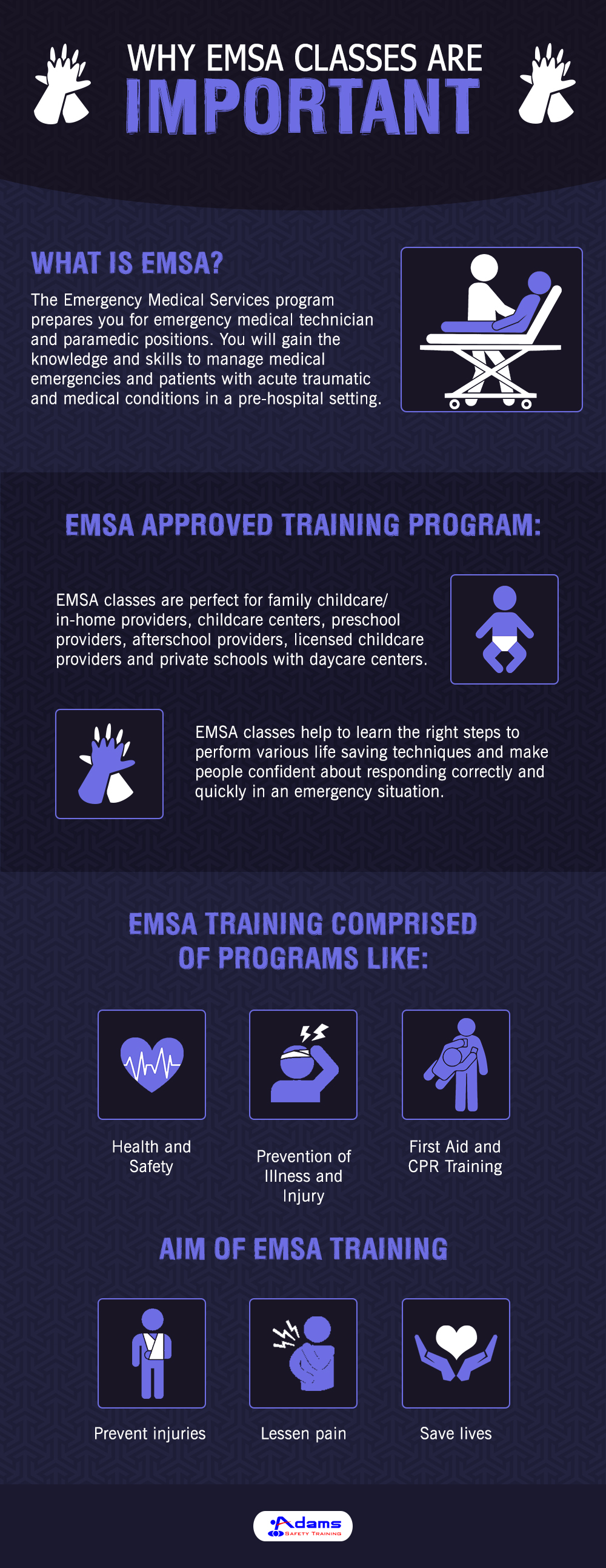
8 Reasons You Should Learn CPR [Infographic]
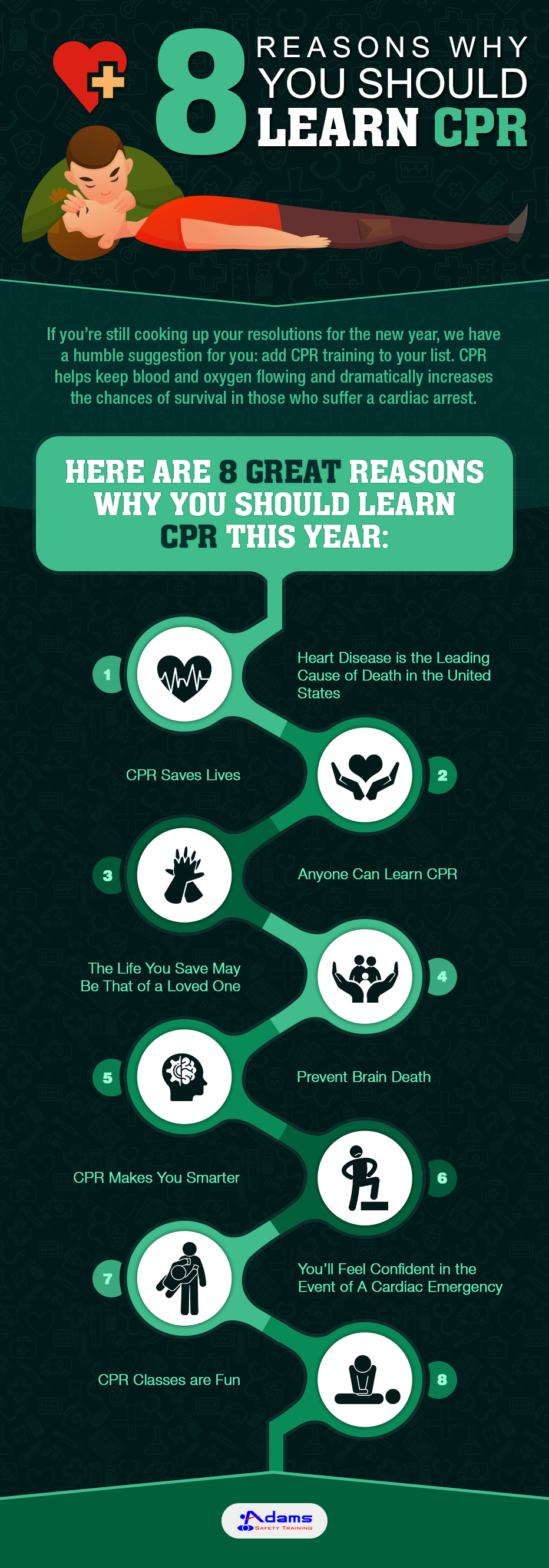
5 Reasons why first aid training is important
First Aid training helps save lives. Adams safety training offers health and safety training for everyone. First Aid knowledge applies to every industry regardless of their size so whether at the workplace, home or school, everyone benefits from it.
From someone close to us to any random person we see on the street who might be in danger, First Aid training comes in handy. It equips us with the right knowledge to help others at the most critical hour of their life.
Here are five reasons why First Aid Training is important:
• Increases safety- The main aim of first aid training is “prevention” in critical, life-endangering situations. It is better to stay safe than to be sorry. Being trained in providing first aid helps to promote a sense of safety and well being amongst people, prompting them to be alert and safe in their surroundings.
• Helps increase patient’s comfort- Getting help from someone who is trained in first aid can bring immediate relief to the patient. Maintaining the right attitude with the patient before help arrives can help the patient relax. One can learn such behaviors only during their first aid training.
• It provides a tool to prevent the situation from becoming worse- The patient’s condition can deteriorate if they don’t receive basic first aid care immediately.
• Encourages a healthy and safe environment- First aid training can help someone assess their surroundings better. Having situational awareness and a desire to be accident-free keeps one safer and decreases the number of accidents that one might get involved in.
• Gives the confidence to care- Being first aid trained means having basic first aid knowledge and being confident in your skills and abilities concerning first aid administration to others.
Overall First Aid training helps us reflect on ourselves too and makes us more agile, alert, and responsive in critical situations.

